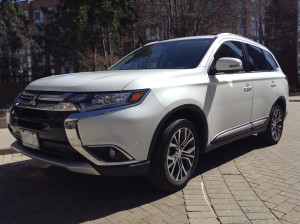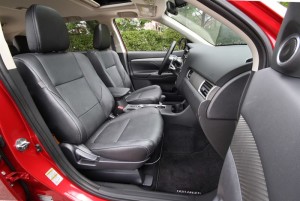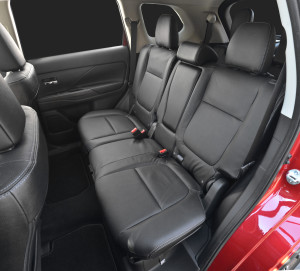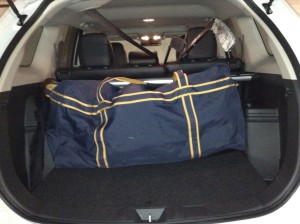In the automotive market, crossovers may be the hottest, most competitive segment. So it’s no surprise Mitsubishi brought a number of refinements to its 2016 Outlander.

First impressions
Mitsubishi didn’t put excessive numbers of curves or details into the body, but the ones they chose work well together.
The front grill slopes to meet the bumper, and recedes upwards to the hood. Metal accents to the sides of the bumper also recede. These details combine to create the “pointed” look of an off-road-ready vehicle. (The four-wheel independent suspension and four-wheel-drive system ensure the reality matches the appearance.) Mitsubishi calls this front design “Dynamic Shield.”
Straight lines run the length of the vehicle’s sides just inches under the windows, leading to a businesslike back end. The result is understated but elegant.
The heated sideview mirrors fold in when the Outlander is off. Enter via the keyless-entry-equipped doors and they slowly swing outwards.
Interior
Leather seats and accents of wood and piano black contributed to the comfortable and subtly luxurious interior of my Premium Package tester Leather also wraps the steering wheel and shift lever.

image courtesy Mitsubishi
A power sunroof, dual zone air conditioning and push-button start add to the high-end feel.
Back seats are generously sized, even with somebody my size (6’5″) in the drivers seat. A rear centre armrest sports cupholders for passengers.

image courtesy Mitsubishi
Hockey bag test
The Outlander offers a massive cargo area. You’re not likely to touch the 60-40 split-folding rear seats of the Outlander unless you move to a new house. This cargo area had room for another hockey bag like mine on the floor, and another two on top were I to remove the privacy cover.

Under-floor compartments keep valuables out of sight.
If you do move house, you can create more cargo space by flipping the back seats forward into the footwell. Before you fold down the rear seat backs, you may be tempted to clean out the chips, snacks, and the odd micro-carabiner that slipped into the space under the seats.
In-car technology
Mitsubishi keeps its 6.1” touchscreen-driven Multi-Communication System setup simple. Large, hard-to-miss icons led to features common to most of today’s vehicles. My tester did feature many of the usual controls via USB, Bluetooth, even satellite radio, though it did not have the optional navigation system. Passably good audio reaches the cabin via 6 speakers driven by 140 watts. A rear-view camera takes over the screen when backing up.
This was enough for me, frankly. I’d like to think Mitsubishi, instead of following the crowd and developing a proprietary in-car system, has instead saved its energy. The Outlander’s system enables the things that mobile phones can’t do. I suspect Mitsu will instead support Google’s and Apple’s in-car systems when they’re ready to do so.
I would push all automakers to travel this route, since modern smartphone integration systems oblige me to use the device if I want to control things like Apple’s Podcasts app and the third-party app Overdrive for audiobooks I borrow from the library. I look forward to the day when automotive audio systems handle these “other” audio apps just as well as they do the standard music players.
The multi-information display between the gauges in the instrument cluster flashed messages, door-open icons and other useful cues when needed. A button to the left of the steering wheel lets the driver view trip data, eco-driving ratings and other information.
Driving
The 2.4L SOHC I4 MIVEC engine switches its intake-valve control between low-speed and high-speed modes depending on how you’re driving to maximize engine performance. On the road, this doesn’t make any difference to performance, which was always adequate and civilized. It was also quiet, thanks to improved sound insulation in the vehicle.
The engine’s power goes through one of six forward gears. Again, Mitsu lets the Outlander make certain decisions. Going uphill, the transaxle prevents unneeded upshifts. Travelling downhill, the transaxle may shift to a lower gear to provide engine braking. Mitsubishi also offers a new continuously variable transmission.
Canada Energuide fuel consumption ratings (L/100 km) are:
- 9.7 city
- 8.1 highway
- 9 combined
The Outlander takes 87 octane fuel in its 60-litre tank
Pricing
The 2016 Mitsubishi Outlander starts at a base MSRP of $27,998. My tester, with optional equipment and other charges, can be had for $33,448.
The Outlander proved a great package of proven driving technologies and a comfortable interior that doesn’t go overboard on gadgetry. Mitsubishi’s competing hard for the value-for-the-money crossover buyer, and the Outlander is a compelling choice.